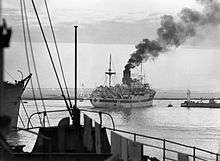HMHS Newfoundland
HMHS Newfoundland was a British Royal Mail Ship that was requisitioned as a hospital ship in the World War II. She was sunk in 1943 in an air attack in the Mediterranean.
_broadside_view.jpg) | |
| History | |
|---|---|
| Name: |
|
| Owner: | Johnston Warren Lines (1925–40)[1] |
| Operator: | Furness, Withy & Co (1925–40)[1] |
| Port of registry: |
|
| Route: | Liverpool – St John's, Newfoundland – Halifax, Nova Scotia – Boston, MA (1925–?) |
| Builder: | Vickers, Sons & Maxim, Barrow-in-Furness[1] |
| Yard number: | 617 |
| Launched: | 24 January 1925 |
| Completed: | June 1925[1] |
| Out of service: | 13 September 1943 |
| Identification: |
|
| Fate: |
Damaged by a Luftwaffe bomb 40 miles off Salerno, 13 September 1943 Scuttled, 14 September 1943 |
| General characteristics | |
| Type: | |
| Tonnage: | 6,791 GRT; 3,828 NT[1] |
| Length: | 406.1 ft (123.8 m)[1] |
| Beam: | 55.4 ft (16.9 m)[1] |
| Draught: | 31.8 ft (9.7 m)[1] |
| Installed power: | 1,047 NHP[1] |
| Propulsion: | Vickers quadruple expansion steam engine[1] |
| Speed: | 15 knots (28 km/h; 17 mph) |
| Notes: | sister ship: RMS Nova Scotia |
Building
Vickers, Sons & Maxim, Ltd of Barrow-in-Furness built Newfoundland for Furness, Withy & Co of Liverpool.[1] Her 1,047 NHP quadruple expansion steam engine was fed by five 215 lbf/in2 single-ended boilers with a total heating surface of 16,095 square feet (1,495 m2).[1] Her boilers were heated by 20 oil-fuelled corrugated furnaces with a grate surface of 377 square feet (35 m2).[1]
Civilian service
Newfoundland worked Furness, Withy's regular transatlantic mail route between Liverpool and Boston via St John's, Newfoundland and Halifax, Nova Scotia.[3] In May 1926 she was joined by a sister ship, RMS Nova Scotia.[4]
Early war service
Newfoundland spent the first part of World War II on her peacetime route, carrying wounded troops from the UK to Canada, and bringing the rehabilitated troops back home.
In April 1943 Newfoundland repatriated some Allied servicemen from Lisbon to Avonmouth, England. Among them was Flight Lieutenant John F. Leeming RAF, who had been captured with Air Marshal Owen Tudor Boyd (as his Aide-de-Camp) in 1940. His escape plan from Vincigliata PG 12 prisoner of war camp in Italy was by cleverly faking a very bad nervous breakdown case. He succeeded so well that the international medical board, with Swiss and Italian doctors, unhesitatingly accepted his case. As he describes in his book:
In the late afternoon (18 April 1943) we went aboard the British hospital ship Newfoundland, which was lying at the quay ready to sail for England. I walked quickly up the gangway, and as I felt my two feet touch the ship's deck I looked up - I suppose I am too sentimental - at the flag flying from the masthead. "Done it!" I said aloud.[5]

Hospital ship
After the Allied invasion of Italy in September 1943, HMHS Newfoundland was assigned as the hospital ship of the Eighth Army, and was one of two hospital ships sent to deliver 103 American nurses to the Salerno beaches on 12 September. The hospital ships were attacked twice that day by dive bombers, and by evening they were joined by a third hospital ship. Concerned by a number of near misses, it was decided to move the ships out to sea and anchor there for the night. All three ships were brightly illuminated and carried standard Red Cross markings to identify them as hospital ships, and their protection under the Geneva Convention.
At 5:00 a.m. on 13 September while under the command of Captain John Eric Wilson O.B.E, Newfoundland was hit by a Henschel Hs 293 air-launched glide bomb 40 nautical miles (74 km) offshore of Salerno. The bomb was launched by a Dornier Do 217 bomber belonging to KG 100. It struck on the boat deck, abaft of the bridge. The ship was only carrying two patients and 34 crew members. Communications were lost but, more importantly, the fire fighting equipment was completely shattered. Mayo came alongside to rescue the patients, and also put a party on board to help with damage control. By now the ship had caught fire. There was another explosion and it became clear that the oil tanks had also caught fire. The injured crew left the boat and 12 crew members battled the fire for a further 36 hours. The ship was beyond repair and was towed further out to sea and intentionally scuttled the day after the attack by the destroyer Plunkett. Of the people on board, six of the British staff nurses and all of the medical officers had been killed.One of the medical officers was Hartas Foxton 1889 - 1943 who had been a GP in Uttoxeter until the War.
References
- Lloyd's Register, Steamers and Motorships (PDF). London: Lloyd's Register. 1935. Retrieved 29 March 2013.
- Lloyd's Register, Steamers and Motorships (PDF). London: Lloyd's Register. 1933. Retrieved 21 May 2013.
- "Furness, Withy & Co". Maritime Timetable Images. Björn Larsson. 2001–2013. Retrieved 29 March 2013.
- Lloyd's Register, Steamers and Motorships (PDF). London: Lloyd's Register. 1941. Archived from the original (PDF) on 28 February 2014. Retrieved 29 March 2013.
- Leeming, John F (1951). Always To-morrow. London: George G. Harrap and Co. pp. 185–6.
Further reading
- Burrell, David (1992). Furness Withy, 1891-1991. Kendal: World Ship Society. ISBN 0905617703.CS1 maint: ref=harv (link)
- Haws, Duncan (2000). Furness Withy. Merchant Fleets. 37. Crowborough: Travel Creatours Ltd. ISBN 094637838X.CS1 maint: ref=harv (link)
- Monahan, Evelyn; Neidel-Greenlee, Rosemary (2003). And If I Perish: Frontline U.S. Army Nurses in World War II. New York: Knopf. ISBN 0-375-41514-9. OCLC 51978030.CS1 maint: ref=harv (link)
External links
- "The Sinking of HMHS Newfoundland". WW2 People's War. BBC Online.